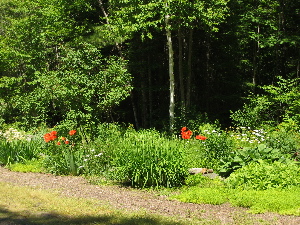XERISCAPING YOUR GARDEN
OK...just WHAT is xeriscaping? Xeriscaping is pretty much defined as growing plants that are drought-adapted while using water saving techniques. As a lazy gardener...this is my idea of the perfect garden. Just plant, water to get the plant established, stand back and enjoy! UMH...did I say weeds are also relatively drought-adapted? I guess it wasn't exactly perfect in every way, was it? Oh, well. ALMOST perfect! You won't have to water NEAR as much. And if you add lots of mulch, even the weeds will be kept at bay. The mulch will also help conserve any water that does fall on your garden.
Try visiting this web site at the NH Department of Environmental Services. It is an entire page on how to go about xeriscaping your garden. However, I will give you you their list of plant materials that will work quite well in a dry situation, in our climate. This means you will use less of your water resources, as well as making your garden easier to handle.
When you choose plant materials to add to your garden, try seriously to work some of these into the plan. You will NOT regret it!
My garden is quite far from a hose, so it really has to depend on the water sent from the heavens. Xeriscaping therefore, really appeals to me.
The following is a list of plant materials (from the NH DES web site given above) well adapted for water-wise landscaping in New Hampshire.
Ornamental Grasses:
Alopecurus pratensis, Foxtail grass, Zone 4
Deschampsia cespitosa, Tufted Hair Grass, Zones 4 & 5
Molina arundinacea, Purple Moor Grass, Zones 4 & 5
Phalaris arundinacea, Ribbon Grass, Zone 4
Trees and Shrubs:
Acer negundo, Box elder
Cotoneaster spp
Crataegus spp., Hawthorn
Juniperus spp, Junipers
Kalmia latifolia, Mountain Laurel
Prunus Americana, American plum
Rosa Rugosa, Beach Rose
Syringa spp, lilac
Perennial Flowers
Achillea spp, Yarrow, Zone 3
Asclepias tuberosa, Butterfly Weed, Zone 3
Baptisia australis, False Indigo, Zone 3
Coreopsis spp, Zone 3
Dianthus plumarius, Grass Pink, Cottage Pink, Zone 3
Echinacea purpurea, Purple Coneflower, Zone 3
Gypsophila paniculata, Baby's Breath, Zone 3
Hemerocallis spp,Daylily, Zones 3-4
Perovskia atriplicifolia, Russian Sage, Zone 5
Rudbeckia spp., Black-eyed Susan, Zones 3-4
Sedum spp.,Stonecrop, Zones 3-4
Stachys spp, Lamb's Ears, Zone 4
Annual Flowers
Cleome spinosa,Spiderflower
Coreopsis tinctoria
Euphorbia marginata,Snow-on-the-Mountain
Gailardia pulchella,Blanket Flower
Helianthus annus,Sunflower
Portulaca grandiflora
Tithonia rotundifolia,Mexican Sunflower
Salvia farinacea,Blue Salvia





3 Comments:
Thanks for the info - I discovered several of my plants are on that list. I still have to water a lot though: I have a couple of rose bushes too.
Woolybuns
I love the whole idea in fact the garden going in very slowly at the side of my house will be dependant on being drought proof since I want one area that I can virtually ignore and still look good. Yarrow is one of the first plants to go in and all the wild flower seeds are for a drought garden.
This comment has been removed by a blog administrator.
Post a Comment
<< Home